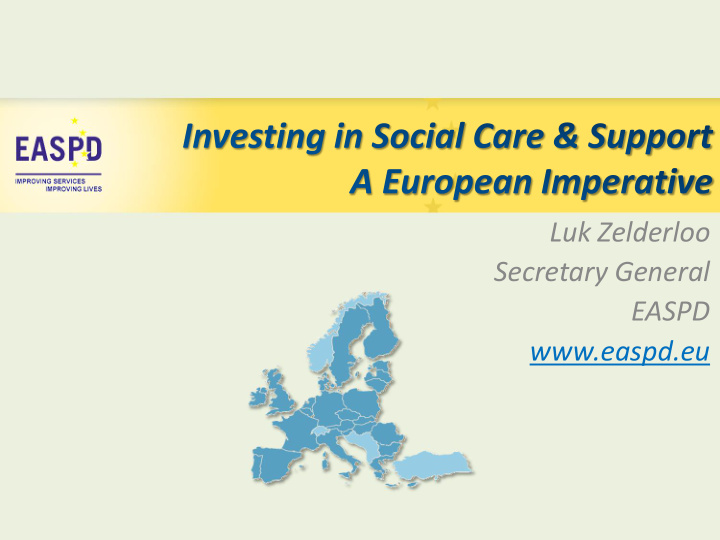



Luk Zelderloo Secretary General EASPD www.easpd.eu
EASPD in Brief European Association of Service Providers for Persons with Disabilities ➢ Based in Brussels, Not for Profit Organisation ➢ Established in 1996 ➢ Objective: Equal opportunities for people with disabilities through effective and high quality service systems in Europe, which are affordable, available and adaptable. ➢ EASPD represents over 15,000 service providers in 33 European countries covering all disabilities.
III. Recommendations A European Strategy for Quality Social Infrastructure - European Fund for Social Infrastructure Development - €5 billion of EU/EIB to help unlock €25 billion investment into social infrastructure - High Level Taskforce for Quality Social Infrastructure - To build European minimum standards & recommend policy frameworks - Support & advise the development of quality projects - Coordinate the Social Investment Councils - National/regional Social Investment Councils in each Member State to build pipeline of bankable quality projects - A European Social Investment Data Collection body
Outline I. Future of Social Care & Support II. Investing in Social Care & Support III. Recommendations
I. Future of Social Care & Support What is the Social Care & Support sector? ➢ Social services are “care & support services for older people, people with disabilities, children, as well as services to reach excluded and disadvantaged groups” ➢ Very heterogenous in type and size, largest section in Europe are “not -for- profit SMEs” ➢ Biggest job creators in Europe: 1.7 million new jobs in ten years
I. Future of Social Care & Support What is the added value of social care & support? ➢ Crucial role in helping people access their rights: ➢ 10 out of 20 principles in the European Pillar of Social Rights require direct involvement of the sector if they are to be implemented ➢ Essential for the development of an inclusive economy, where all people can play an active role in society and on the labour market (inclusive growth) ➢ Access to quality social care and support is very important for gender balance ➢ Huge job creation potential, including in rural and less “developed” areas
I. Future of Social Care & Support What are the major trends? ➢ Transition to community-based social care and support ➢ Demographic changes, evolving family patterns and work-life balance ➢ Economic developments ➢ Digital revolution
I. Future of Social Care & Support What does this all mean for social care and support? ➢ Individualised support, person-centred planning, co-produced services and the empowerment of individuals and their families should be at the heart of all services ➢ More and more engagement with mainstream services (local authorities, businesses, schools and universities, social housing sector, public employment services, etc) ➢ Improve the attractiveness of the jobs in the sector, especially for young people, for men and women; through decent jobs, working conditions and career paths. INVESTMENT IS NEEDED!
II. Investing in Social Care & Support The public investment imperative! ➢ Quality care and support must be affordable, accessable, adaptable and available to all people in need. ➢ Evidence shows that adequate public Investment is only long- term guarantee of such services, crucial to avoid creaming effect or further staff shortages ➢ Investment logic is needed!
II. Investing in Social Care & Support What role for private investment? ➢ Unlocking private investment to accelerate access to capital for long-term investments, in particular in infrastructure, can be beneficial for the user, the service provider, the investor and society as a whole. ➢ Quality private investment could play a crucial role in building the social infrastructure of tomorrow. It should not be seen as the way to finance the day to day cost provision of social care & support.
II. Investing in Social Care & Support EU Investment Plan: potential & reality ➢ EU Investment Plan helps SMEs and Infrastructure projects get access to better quality loans, by using EU&EIB money as a guarantee for private investors ➢ A few interesting examples in the broader social sector: Primary Care Centres in Ireland, social housing in Barcelona, refurbishing schools in Finland. ➢ -1% taken up by the social care & support sector. Similarly limited uptake by EIB standard procedures.
II. Investing in Social Care & Support What are the barriers? ➢ Misconceptions and poor communication ➢ Expertise gap and lack of capacity ➢ Unsuitable tools and instruments
III. Recommendations Annual Growth Survey 2018 - “Europeans need affordable, accessible and quality services (...) such as childcare, out-of-school care, education, training, housing, health services and long- term care” - “there would be merit in establishing a financial framework conducive to investment (into human capital development and infrastructure projects) and the mobilisation of private capital that allows the combination of financial instruments and grants to help projects get off the ground” We agree and have some ideas for practical implementation!
III. Recommendations A European Strategy for Quality Social Infrastructure - European Fund for Social Infrastructure Development - €5 billion of EU/EIB to help unlock €25 billion investment into social infrastructure - High Level Taskforce for Quality Social Infrastructure - To build European minimum standards & recommend policy frameworks - Support & advise the development of quality projects - Coordinate the Social Investment Councils - National/regional Social Investment Councils in each Member State to build pipeline of bankable quality projects - A European Social Investment Data Collection body
Any questions? Thank you for your attention! www.easpd.eu Luk.zelderloo@easpd.eu 15
Recommend
More recommend